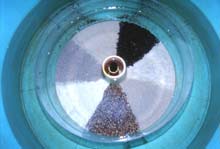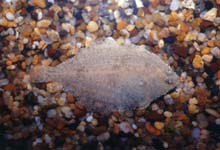

Fisheries Behavioral Ecology
Research Topic 2:
Fish Habitat
In 1996, the US Congress mandated that federal fisheries must be managed with consideration of Essential Fish Habitat (EFH), and that the habitats of resource species be managed and protected for long-term sustainability of fisheries. Much of the subsequent research involved compiling data on distribution, abundance and life history of the 700 federally managed fishery stocks. However, EFH has been defined as "those waters and substrate necessary to fish for spawning, breeding, feeding or growth to maturity.” Identification and protection of critical habitats necessitates a fundamental understanding of the habitat requirements and ecological processes that affect distribution, abundance, and production of fishes in all life history stages. Habitat-related research of the Fisheries Behavioral Ecology Program has focused on bottom-dwelling fishes that comprise large commercial fisheries in Alaska, and experimental analysis of habitat associations. Research emphasis has been placed on juvenile stages of flatfishes with the purpose of identifying the principles that determine habitat quality and the potential impacts of fishing gear on fish habitat.
Recent projects and current research efforts:
- Size-related sediment preferences and burial capabilities
|
 |
 |
Apparatus for testing sediment preferences in flatfishes. Seven sediment types, pebbles to mud, interspersed and arranged in equal wedges 25-40 mm deep. |
Juvenile northern rock sole tested for size-specific sediment preferences. |
- Role of physical structures, such as sponges, bryozoans, and shell material, in habitat preferences by flatfishes
|
- Mediation of predator-prey relationships by physical structures removed by fishing gear
- Field investigation of fish habitat associations, and survey methods for habitat research
- Integration of global positioning system (GPS) navigation with video camera sled work (see pictures below) so that habitats and fish distributions can be analyzed through both multivariate statistical approach and geographic information systems (GIS) for mapping and spatially-explicit interpretation
|
Research Topic 1: Fish and Environment
Research Topic 2: Fish Habitat
Research Topic 3: Bycatch Mortality
Research Topic 4: Fishing Gear
Last updated
11 April, 2007
FBE Webmaster
|